| Common Name: |
Common Calamint |
| Botanical Name: |
Calamintha sylvatica syn. C. ascendens, C. officinalis |
| Genus: |
Calamintha |
| Family: |
Lamiaceae |
| Cultivation: |
Well-drained to dry, neutral to alkaline soil in sun. |
| Propagation: |
By seed sown under cover in spring or autumn; by softwood cuttings in early summer; by division in spring. |
| Harvest: |
Flowering plants and leaves are cut in summer and used fresh, or dried for infusions. |
| Native Location: |
Eurasia, Middle East |
| Height: |
60cm (24in) |
| Width: |
60cm (24in) |
| Hardiness: |
Z4-9 |
| Parts Used: |
Whole plant, leaves |
| Properties: |
Like C. nepeta, but not as strong |
| Medicinal Uses: |
As for C. nepeta |
| Culinary Uses: |
Leaves have a mint-marjoram flavor, used to flavor roasts, "gamy" meat, and vegetables, such as zucchini and mushrooms. |
| Bibliography: |
Encyclopedia of Herbs by Deni Brown. Copyright © 1995, 2001 Dorling Kindersley Limited. pg 149-150
|

